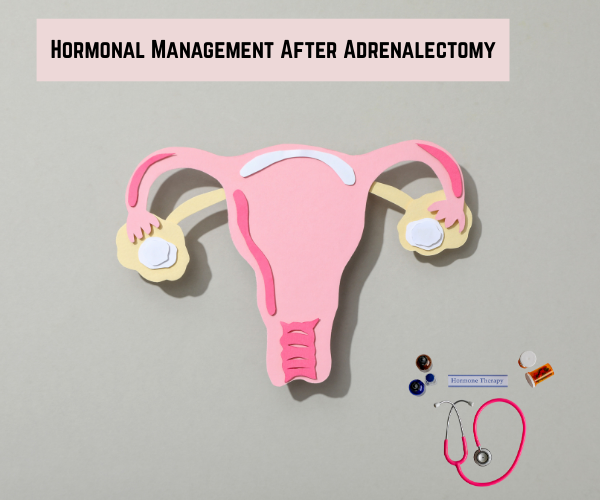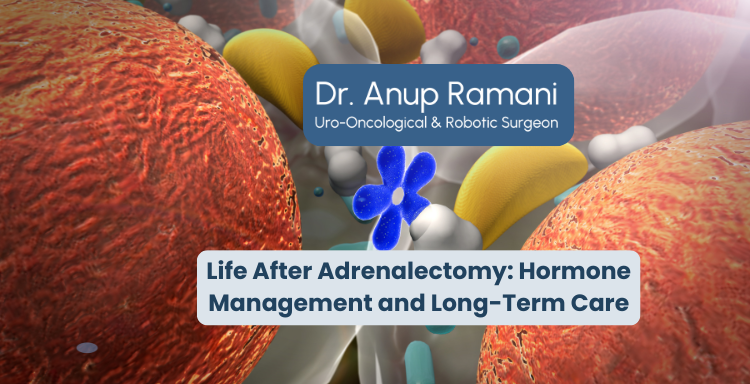Dr Anup Ramani @ Copyright 2024
By Dr. Anup Ramani
An adrenalectomy is the surgical removal of one or both adrenal glands. These glands are essential in producing hormones that regulate metabolism, blood pressure, the immune response, and the body’s stress response. Whether one or both adrenal glands are removed, life after adrenalectomy requires proper management of hormone replacement, recovery, and long-term care. This article will answer common questions regarding life after adrenalectomy, including hormone management, recovery challenges, and lifestyle adjustments.
What is an adrenalectomy and why is it performed?
An adrenalectomy is a surgical procedure to remove one or both adrenal glands. The adrenal glands are responsible for producing vital hormones such as cortisol, aldosterone, and adrenaline. There are two types of adrenalectomy:
- Unilateral adrenalectomy: Removal of one adrenal gland.
- Bilateral adrenalectomy: Removal of both adrenal glands.
It is typically performed to treat conditions like:
- Adrenal tumors (e.g., pheochromocytoma, aldosterone-producing adenomas, or cortisol-producing tumors).
- Cushing’s syndrome, Conn’s syndrome, or pheochromocytoma.
- Severe adrenal gland disorders or injuries.
What is the recovery process like after adrenalectomy?
Recovery after adrenalectomy depends on whether one or both adrenal glands are removed and the surgical method used.
- Laparoscopic adrenalectomy (including robotic approaches) involves smaller incisions, leading to a quicker recovery time and shorter hospital stays. Many patients can return to work within a few days to a couple of weeks.
- Post-surgery care: Light activities like walking are encouraged to promote healing. Strenuous activities and heavy lifting should be avoided for several weeks.
Open Surgery
- Open adrenalectomy involves a larger incision, requiring a longer hospital stay (typically 3-5 days) and a longer recovery period (4-6 weeks).
- Post-surgery care: Similar to laparoscopic surgery, but with more emphasis on managing pain, avoiding physical exertion, and following a more gradual increase in activity.
How is pain managed after adrenalectomy?
Pain management is an essential part of recovery after adrenalectomy:
- Post-surgery pain: Mild to moderate pain is common after surgery, especially with open procedures.
- Pain medications: Non-narcotic pain relief is often prescribed to manage discomfort. The doctor will recommend appropriate medications to reduce pain and inflammation.
- Wound care: Incisions need to be kept clean and dry. Steri-strips may be applied to protect the wound, and they should be left in place until they naturally fall off or as directed by the doctor.
What hormone management is needed after adrenalectomy?
Hormone management is critical after an adrenalectomy, especially if both adrenal glands are removed.
Unilateral Adrenalectomy (One Gland Removed)
- In most cases, the remaining adrenal gland can compensate and produce adequate amounts of hormones.
- Hormone replacement therapy (HRT) may not be necessary, but regular monitoring of hormone levels is essential.
Bilateral Adrenalectomy (Both Glands Removed)

- If both adrenal glands are removed, the body no longer produces vital hormones like cortisol and aldosterone.
- Lifelong HRT is required, typically involving:
- Hydrocortisone: To replace cortisol.
- Fludrocortisone: To replace aldosterone.
- Regular blood tests and follow-up appointments are necessary to adjust medication dosages.
What Our Patients Are Saying
What long-term effects should be monitored after adrenalectomy?
There are several long-term considerations to be aware of following adrenalectomy:
Hormonal Imbalance
- After bilateral adrenalectomy, adrenal insufficiency may develop, requiring lifelong hormone replacement therapy (HRT).
- Blood pressure management: Some patients may require ongoing medication for blood pressure issues, especially if the adrenal gland removed was responsible for hypertension.
Quality of Life
- Recovery from Cushing’s syndrome: If adrenalectomy was performed for Cushing’s syndrome, patients often experience a significant improvement in symptoms like weight gain, fatigue, and mood swings.
- Overall energy levels: Patients may experience changes in energy levels, metabolism, or stress response, which can impact their daily life and quality of life.
How can I manage my health and maintain a good quality of life after adrenalectomy?
To live a healthy life after adrenalectomy, you must make several adjustments:
Diet
- A balanced diet rich in fruits, vegetables, lean proteins, and healthy fats is recommended.
- Staying well-hydrated is especially crucial in warmer climates or for those with adrenal insufficiency, as fluid balance is affected by low aldosterone levels.
- Consult with a dietitian if you have dietary concerns, particularly if you experience changes in metabolism or blood sugar levels after surgery.
Exercise
- Gradually increase physical activity once the surgeon clears you to do so. Exercise helps maintain overall health and promotes a stable mood.
- Avoid heavy lifting or strenuous activity during the recovery period.
Stress Management
- Relaxation techniques, such as yoga, meditation, or deep breathing exercises, can help manage stress, which in turn supports hormone balance and emotional well-being.
How important are follow-up appointments after adrenalectomy?
Follow-up care is essential after adrenalectomy to ensure proper hormone management and overall health:
- Regular check-ups: Follow-up appointments are necessary to monitor your hormone levels and adjust medications as needed. This includes routine blood and urine tests to assess your body’s response to hormone replacement.
- Endocrine monitoring: If both glands were removed, you will need lifelong monitoring to ensure that your body is getting the right amount of cortisol and aldosterone.
- Blood pressure monitoring: If you had hypertension related to the adrenal tumor, regular monitoring of blood pressure is essential to adjust medications accordingly.
What are the risks associated with adrenalectomy?
While adrenalectomy is a common procedure, it carries certain risks, including:
- Infection: As with any surgery, there’s a risk of infection at the incision site.
- Bleeding: There may be bleeding during or after the surgery, especially with open procedures.
- Hormonal imbalance: After bilateral adrenalectomy, the lack of natural cortisol and aldosterone production can lead to adrenal insufficiency, which requires prompt attention and medication adjustments.
Blood pressure instability: Monitoring and adjusting medication for blood pressure are crucial, especially if the adrenal glands affected blood pressure regulation.
How can I ensure the best recovery after adrenalectomy?
For a successful recovery, it’s essential to follow these steps:
- Adhere to medication schedules: Take hormone replacement medications as prescribed and report any side effects or changes in symptoms to your doctor.
- Monitor your body’s signals: Pay attention to how your body reacts to new medications and changes, especially in the early stages after surgery.
- Maintain a healthy lifestyle: Follow a nutritious diet, engage in regular exercise, and practice stress management to improve your overall well-being.
- Stay connected with healthcare professionals: Keep up with regular follow-ups and communicate openly with your doctors about any concerns.
Can I live a normal life after adrenalectomy?
Yes, many patients go on to live normal, fulfilling lives after adrenalectomy, especially if they follow their prescribed hormone replacement therapy and recovery plans. Adrenalectomy is a significant procedure, but with appropriate hormone management, lifestyle adjustments, and regular medical monitoring, individuals can maintain good health and enjoy a high quality of life.
Conclusion
Life after adrenalectomy involves adjusting to new hormone management practices, maintaining a healthy lifestyle, and undergoing regular medical check-ups. If only one adrenal gland is removed, hormone therapy may not be necessary, but if both glands are removed, lifelong hormone replacement therapy is essential. Recovery can be challenging, but with proper care, individuals can thrive post-surgery and live a healthy life. Consistent follow-up and open communication with your healthcare provider are crucial for managing long-term care and ensuring optimal health after adrenal surgery.
About Author

Uro-Oncological & Robotic Surgeon
Dr. Anup Ramani is a robotic uro-oncological surgeon and an internationally recognized expert in robotic surgery for prostate, kidney and urinary bladder cancers. With more than two decades of robotic experience and 2,000+ robotic procedures, he brings unmatched precision and outcomes to complex uro-oncology cases. He is widely published in his field and is known for a personal, transparent approach-often spending over an hour in initial consultations to educate patients on its disease, surgery and recovery. His expertise spans prostate cancer treatment, kidney and bladder cancer surgery, adrenal gland surgery, kidney stone treatment, penile cancer surgery and enlarged prostate management. Dr. Ramani advocates the advantages of robotic surgery-magnified 3D vision, tremor-filtered precision, minimal scarring, lower blood loss and faster recovery-helping patients return to life sooner.
Table of Contents
Recent Blogs
Best Uro-Oncological surgeon
Specialist in India for Robotic Surgery
MCh, DNB, MS, DNB
Dr. Anup Ramani
CONTACT
Uro-Oncologist in India,
Best Robotic Surgeon for Uro Oncology Surgery
1407, One Lodha Place Next to World Towers Senapati Bapat Marg, Worli, Mumbai. 400013.
Dr Anup Ramani @ Copyright 2024 – Website Maintenance, SEO & GEO by Opal Infotech
- Partial penectomy is done in cases where glans and distal penis is involved with carcinoma.
- Partial penectomy is a type of organ-preserving surgery. Preservation of sexual and micturational function depends on the surgical dissection and reconstruction of residual urethra.
- Patients who develop stones in the kidney or ureter, often experience severe pain.
- This condition usually needs a procedure to remove the kidney stones.
- This procedure is called ureteroscopy and is performed very commonly.
- It does not require any cuts and hence it is painless.
- The procedure is performed with an endoscope inserted through the penis under spinal anesthesia.
- The scope is inserted through the penis into the kidney and stones are dissolved with a laser.
- The procedure takes about 40-50 minutes.
- A catheter (urine pipe) is kept after the procedure to drain the bladder. A stent is kept in the kidney at the same time.
- Patient is mobile and walking in the room the same evening.
- Hospital stay is one night and patient is discharged the next day after removal of the catheter.
- Patient has to come back after six weeks to remove the stent in the kidney.
- Patients can resume office a week after surgery and heavy activities like running, weight lifting, a month after the procedure.
- We offer fixed packages for this procedure which can be obtained by calling our helpline +91 9967666060.
- Men with an enlarged prostate, which is a normal ageing changes, often experiencing difficulty passing urine. This condition usually needs a procedure to trim the prostate and relieve the blockage.
- This procedure is called TURP and is performed very commonly.
- It does not require any cuts and hence it is painless.
- The procedure is performed with an endoscope inserted through the penis under spinal anaesthesia.
- The overgrown prostate is dissolved with a laser bloodlessly.
- The procedure takes about 40 minutes.
- A catheter (urine pipe) is kept after the procedure to drain the bladder.
- Patient is mobile and walking in the room the same evening.
- Hospital stay is two nights and patient is discharged with the catheter, which is removed after 4 days.
- Patients can resume office a week after surgery and heavy activities like running, weight lifting, a month after the procedure.
- We offer fixed packages for this procedure which can be obtained by calling our helpline +91 9967666060.
-
Robotic adrenalectomy is a sophisticated, complex surgery and it is very important that an experienced surgeon performs this surgery to avoid major complications.
-
Once the anesthesia is done, and patient positioned, three micro cuts (3mm each) are made in the patient’s abdomen.
-
The arms of the Da Vinci robot are connected to the cuts via ports (tubes).
-
Dr. Ramani then sits in the controlling console to perform the surgery.
-
On an average, a robotic adrenalectomy takes one hour.
-
The surgery is almost completely bloodless and there has never been any need to transfuse blood after surgery.
-
A urine catheter and bag to drain the bladder is inserted during surgery.
-
A tiny drain pipe may be inserted in the surgical side of the abdomen, connected to a bag.
-
Patient is kept nil-by-mouth the day of the surgery, with IV fluids. Sips of water are started the next day and solid food by day three.
-
The drain pipe, if kept, is removed in the room on day 2 after surgery.
-
The catheter is removed on day two after surgery.
-
Total hospital stay for robotic adrenalectomy is 4 nights (including night before surgery).
-
Post discharge, a doctor from the surgical team visits the patient at home/ hotel room once every day.
On the day of discharge, patient is totally self-sufficient. They are able to walk freely without any pain, dress themselves, shower, toilet and they do not need to hire any nurse or help at home. Almost all patients are back to work within 2 weeks of surgery.
Heavy activities like running, weight lifting can be resumed after a month
Follow up after an adrenalectomy is in the form of CT scans, once a year for 5 years.
Local patients usually meet Dr. Ramani after two weeks to discuss report.Outstation patients are counselled on a phone consultation.
- Dr. Ramani is one of the very few surgeons in India who has the expertise to perform a robotic surgery for bladder cancer, which includes removing the urinary bladder and reconstructing a new bladder robotically.
- Robotic radical cystectomy is an extremely sophisticated, complex surgery and it is very important that an experienced surgeon performs this surgery to avoid major complications.
- Once the anaesthesia is done, and patient positioned, six micro cuts (3mm each) are made in the patient’s abdomen.
- The arms of the Da Vinci robot are connected to the cuts via ports (tubes).
- Dr. Ramani then sits in the controlling console to perform the surgery.
- On an average, a robotic radical cystectomy with an ileal conduit takes 3-4 hours.
- The surgery is almost completely bloodless and there has never been any need to transfuse blood after surgery.
- A urine catheter and bag to drain the new bladder is inserted during surgery.
- Two tiny drain pipe in inserted in the surgical side of the abdomen, connected to a bag.
- Patient is kept nil-by-mouth for 4 days after surgery with IV supplementation of patient’s daily requirements of calories, fats, carbohydrates, proteins and electrolytes.
- The drain pipes are removed in the room on day 3-5 after surgery.
- Total hospital stay for radical cystectomy is 8 nights (including night before surgery).
- Post discharge, a doctor from the surgical team visits the patient at home/ hotel room once every day.
- On the day of discharge, patient is totally self-sufficient. They are able to walk freely without any pain, dress themselves, shower, toilet and they do not need to hire any nurse or help at home.
- Almost all patients are back to work within 6 weeks of surgery. Heavy activities like running, weight lifting can be resumed after two months.
Follow up after a radical a cystectomy is in the form of CT scans, once a year for 5 years.
Histopathology report: Local patients usually meet Dr. Ramani after two weeks to discuss report.
Outstation patients are counselled on a phone consult. Depending on the report, patient may or may not need chemotherapy after surgery.
If chemo is needed, patients may choose to get it done with a medical oncologist of their choice or avail the services of one of the four medical oncologists on our team.
- Robotic partial nephrectomy is a sophisticated, complex surgery and it is very important that an experienced surgeon performs this surgery to avoid major complications. Robotic radical (total) nephrectomy is
- relatively easier but still requires significant experience to consistently deliver results.
- Once the anaesthesia is done, and patient positioned, five micro cuts (3mm each) are made in the patient’s abdomen.
- The arms of the Da Vinci robot are connected to the cuts via ports (tubes).
- Dr. Ramani then sits in the controlling console to perform the surgery.
- On an average, a robotic radical nephrectomy takes one hour and a robotic partial nephrectomy takes about an hour and half.
- The surgery is almost completely bloodless and there has never been any need to transfuse blood after surgery.
- A urine catheter and bag to drain the bladder is inserted during surgery.
- A tiny drain pipe in inserted in the surgical side of the abdomen, connected to a bag.
- Patient is kept nil-by-mouth the day of the surgery, with IV fluids. Sips of water are started the next day and solid food by day three.
- The drain pipe is removed in the room on day 3 after surgery. The catheter is removed on day two after surgery.
- Total hospital stay for radical/partial nephrectomy is 4 nights (including night before surgery).
- Post discharge, a doctor from the surgical team visits the patient at home/ hotel room once every day.
- On the day of discharge, patient is totally self- sufficient.
- They are able to walk freely without any pain, dress themselves, shower, toilet and they do not need to hire any nurse or help at home.
- Almost all patients are back to work within 2-3 weeks of surgery.
- Heavy activities like running, weight lifting can be resumed after a month.
- Follow up after a radical/partial Nephrectomy is in the form of CT scans, once a year for 5 years.
- Local patients usually meet Dr. Ramani after two weeks to discuss report.
- Outstation patients are counselled on a phone consultation.






